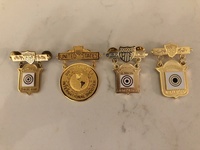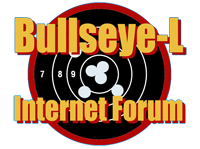Trigger Psychology
+5
Wobbley
chopper
john bickar
SteveT
mspingeld
9 posters
Page 1 of 1
 Trigger Psychology
Trigger Psychology
It's clear to me that trigger speed is the answer to me progressing. I'm too slow in slow fire and too fast in sustained. When I do it right, the shots are within my ability to hold, typically 9 ring. I can articulate proper trigger speed, I can visualize proper trigger speed but, when I'm shooting, I execute proper trigger speed SOME of the time. Sometimes I think I'd shoot better if my eyes were closed and I didn't see that big black dot of distraction. I hate that thing!
How can I fix this?
I'm not ignoring the other fundamentals but, like many others, this is the one that will give me the most bang for the buck.
How can I fix this?
I'm not ignoring the other fundamentals but, like many others, this is the one that will give me the most bang for the buck.
mspingeld- Admin
- Posts : 812
Join date : 2014-04-19
Age : 63
Location : New Jersey
 Re: Trigger Psychology
Re: Trigger Psychology
Visualization and dry fire. Do it a few thousand times and it should become habit.
At the range, dry fire once or as many times as you need, then live fire once.
Use the progression drill but instead of using the target to evaluate a good vs bad shot, use your trigger pull.
At the range, dry fire once or as many times as you need, then live fire once.
Use the progression drill but instead of using the target to evaluate a good vs bad shot, use your trigger pull.
 Re: Trigger Psychology
Re: Trigger Psychology
What's your PT regimen like?
I find that my trigger control is better when I spend more time in my optimal aiming area. That has a couple of components: a small hold, and/or a slow hold. Those two components are not always simultaneously present. When they are, it's more conducive to putting complete mental focus on trigger squeeze.
I should mention that I'm a "conscious trigger" rather than "conscious sights" shooter, which puts me in the minority, but I believe that the concept of "spending more time in your optimal aiming area" translates.
I find that my trigger control is better when I spend more time in my optimal aiming area. That has a couple of components: a small hold, and/or a slow hold. Those two components are not always simultaneously present. When they are, it's more conducive to putting complete mental focus on trigger squeeze.
I should mention that I'm a "conscious trigger" rather than "conscious sights" shooter, which puts me in the minority, but I believe that the concept of "spending more time in your optimal aiming area" translates.

john bickar- Posts : 2144
Join date : 2011-07-09
Age : 100
Location : Menlo Park, CA
 Re: Trigger Psychology
Re: Trigger Psychology
John, could you explain small and slow hold in your process. I was wondering, do you use open sights rather than a dot, and is that why you're a conscious trigger shooter?john bickar wrote:What's your PT regimen like?
I find that my trigger control is better when I spend more time in my optimal aiming area. That has a couple of components: a small hold, and/or a slow hold. Those two components are not always simultaneously present. When they are, it's more conducive to putting complete mental focus on trigger squeeze.
I should mention that I'm a "conscious trigger" rather than "conscious sights" shooter, which puts me in the minority, but I believe that the concept of "spending more time in your optimal aiming area" translates.
Stan
chopper- Posts : 795
Join date : 2013-10-29
Age : 72
Location : Western Iowa
 Re: Trigger Psychology
Re: Trigger Psychology
“small hold” means to me that the dot appears to be bouncing in the 10 ring or smaller. John might mean it is bouncing in the X.
“Slow hold” means to me the hold area is moving slower. If it’s in the 10 ring at the “small hold” time, then the shot will be a 10.
This is why we train either dry or with live. We also need to be consistent so when we “build our position” we center the small hold area. My “normal” position right now is a starting point. I still have to adjust and I’m not 100% consistent in that. Most often my “slow and small” hold area is in the 10 - 9 ring at 6. But when I try to adjust it falls apart….frustrating.
“Slow hold” means to me the hold area is moving slower. If it’s in the 10 ring at the “small hold” time, then the shot will be a 10.
This is why we train either dry or with live. We also need to be consistent so when we “build our position” we center the small hold area. My “normal” position right now is a starting point. I still have to adjust and I’m not 100% consistent in that. Most often my “slow and small” hold area is in the 10 - 9 ring at 6. But when I try to adjust it falls apart….frustrating.

Wobbley- Admin
- Posts : 4569
Join date : 2015-02-12
 Re: Trigger Psychology
Re: Trigger Psychology
Hold, and breathing, are inclusive.
I have realized that getting on target does not actually involve sighting in. I get on target, or very close, and breath, before taking up a sight picture for the first time.
Then, there are 3-5 seconds (for me) to release the shot on target. More than that, I find another breath is needed in order to ensure a relaxed shot. Otherwise, one must abandon the shot or hold extra long.
Holding extra long works, if one accepts a less than perfect sight picture during release. These shots often involve a point reduction. However, they are not always bad shots; for me.
Shot process-
Breath, Breath, Draw on target without looking at sights, breath, sight in, trigger the shot, hold for follow through and sight picture check. Call shot.
That’s where the 9’s and 10’s are.
For rapid fire, I say ‘just do it.’ Timed and rapid fire fix themselves, for me.
By the way, I shoot iron sights exclusively.
I have realized that getting on target does not actually involve sighting in. I get on target, or very close, and breath, before taking up a sight picture for the first time.
Then, there are 3-5 seconds (for me) to release the shot on target. More than that, I find another breath is needed in order to ensure a relaxed shot. Otherwise, one must abandon the shot or hold extra long.
Holding extra long works, if one accepts a less than perfect sight picture during release. These shots often involve a point reduction. However, they are not always bad shots; for me.
Shot process-
Breath, Breath, Draw on target without looking at sights, breath, sight in, trigger the shot, hold for follow through and sight picture check. Call shot.
That’s where the 9’s and 10’s are.
For rapid fire, I say ‘just do it.’ Timed and rapid fire fix themselves, for me.
By the way, I shoot iron sights exclusively.
Last edited by 641 on 4/7/2022, 2:39 pm; edited 3 times in total (Reason for editing : Iron sights, exclusively!)

641- Posts : 37
Join date : 2011-09-28
Location : Ohio
 Re: Trigger Psychology
Re: Trigger Psychology
You may be focusing on something that will not help you progress. Might I suggest you focus on sight picture while building trigger pressure into the sight picture. This resolves many of the issues in your shot process. Your most stable hold will be within 20 seconds or less after you settle into the black and the shot should break within this time period. This works for both SF and TF/RF.
mhayford45- Posts : 250
Join date : 2013-02-21
Location : MI
 Re: Trigger Psychology
Re: Trigger Psychology
Most of you are going to laugh at me, but do everything that has been suggested - don't stop. In addition dry-fire with your eyes closed over and over. After a while, you will start to notice things that you weren't aware of before. I've done this, and tried dry-firing very, very slowly, just to learn the "feel" of what happens when you pull the trigger. To keep it "real", I use a snap cap.mspingeld wrote:........Sometimes I think I'd shoot better if my eyes were closed and I didn't see that big black dot of distraction. I hate that thing!.............
You might not notice anything at first, but without the distraction of all your other senses suggesting what is happening, you'll start learning how to be all that much smoother.
All that distraction does is, well, distract you from what you're concentrating on.
Once you know what to "feel for", you can gradually speed things up a little at a time. You might notice that your finger isn't in the perfect place on the trigger, and other things that you never noticed before.....

mikemyers- Posts : 4234
Join date : 2016-07-26
Age : 80
Location : South Florida, and India
DireWolf53 likes this post
 Re: Trigger Psychology
Re: Trigger Psychology
Hey Mike,
I'd suggest dry firing on a blank wall. Use the Bullseye Timer app and do 1 and 2 drills. Focus on sight alignment as you squeeze the trigger. Work on taking one shot in the two shot drill to push you a little to keep squeezing the trigger for slow fire.
When I started shooting, I hated the blank paper drill in the Handbook because with no aiming reference my group was crap. Now I spend more time dry firing on a blank wall than anything. That might be partially due to having a 3.5yo and an 11mo old, but who's counting!
I'd suggest dry firing on a blank wall. Use the Bullseye Timer app and do 1 and 2 drills. Focus on sight alignment as you squeeze the trigger. Work on taking one shot in the two shot drill to push you a little to keep squeezing the trigger for slow fire.
When I started shooting, I hated the blank paper drill in the Handbook because with no aiming reference my group was crap. Now I spend more time dry firing on a blank wall than anything. That might be partially due to having a 3.5yo and an 11mo old, but who's counting!
Soupy44- Posts : 247
Join date : 2016-10-24
Location : Raleigh, NC
mspingeld likes this post
 Similar topics
Similar topics» Failure psychology
» Psychology of the mind
» Text for Fundamentals and Psychology of Precision Pistol
» Gunsmith question - Roll trigger "feel" vs trigger travel
» Roll trigger on existing stock trigger group
» Psychology of the mind
» Text for Fundamentals and Psychology of Precision Pistol
» Gunsmith question - Roll trigger "feel" vs trigger travel
» Roll trigger on existing stock trigger group
Page 1 of 1
Permissions in this forum:
You cannot reply to topics in this forum|
|
|
